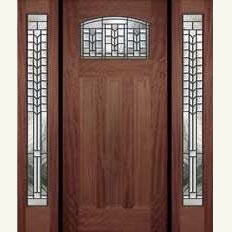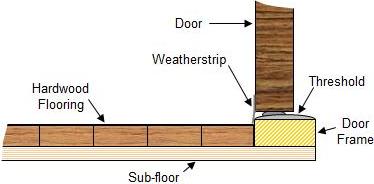One of the most common mistakes made by home handymen and new contractors is related to the installation of entry doors
Today, almost all entry doors are delivered pre-hung in a frame. Where sidelites, glass panels mounted beside the door on one or both sides are included they are usually pre-installed in the same frame, as shown in Figure 1.

Figure 1 - Entry door with sidelites
While having all of the components of the entry door pre-mounted makes the installation much easier and generally insures a tight fitting door with equal spacing all around the door frame it creates a secondary problem which is not uncommon, especially in new construction.
entry doors are usually installed early in the construction phase. The intent is to close in the home in order to protect it against the elements. When the framers arrive on site, they will determine the rough openings for windows and doors. These holes
in the framing should allow for the correct installation of the entry doors mounted in their door frames.
In the case of a concrete pad, the entry door frame rough-in will generally be measured from the top of the concrete. In the case of a home that has floor joists and a sub-floor the rough-in opening will be measured from the top of the sub-floor.
While these measurements would appear to make sense, they can create a major problem. Most entry door frames have a piece of lumber below the door and combined with the metal threshold, will raise the base of the door off the concrete or wood sub-floor by approximately 1 1/4 inches, as shown in Figure 2.

Figure 2 - Floor relative to entry door
On the inside of the entry door finished flooring is laid on the concrete or wood sub-floor. Depending on what type of finished flooring is installed, the height of the floor can easily rise by 3/4 to 1 inch. Ceramic, porcelain, marble, granite and other natural stone floors can be 3/8 to 1/2 inch thick and are often laid on top of a secondary sub-flooring material which in itself can be 1/4 to 5/8 inch thick. Hardwood flooring is often 3/4 inches thick, as shown in Figure 2.
You might add up these numbers and think that the 1 1/2 inch raise provided with the original door frame is still sufficient to handle the thickest of finished flooring materials and any additional sub-flooring material, and in most cases it will.
It may however, not be sufficient to allow the weather stripping on the bottom of the entry door to move freely above the finished flooring when the door is opened.
Another item that is not included in the calculation for the bottom of the entry door is that many homeowners like to have a rug placed on the interior side of entry doors.
As a matter of fact, it is suggested that rugs be used at all entry ways when installing hardwood to protect it from grit that may be tracked in on the bottom of shoes, which will scratch the hardwood flooring finish. If the door does not have sufficient clearance on the bottom it will catch on the rugs and either not open fully or actually shift the position of the rug.
Wall to wall carpeting, with a plush, high pile and associated underpad can easily raise a sub-floor up by the 1 1/4 inches built into the door frame construction.
To avoid having the entry door at a level that is not suitable for the interior floor finishes, the homeowner and builder have a joint responsibility to ensure that the rough-in carpenters are fully aware of the thickness of interior flooring and any additional floor covering products that maybe used.
As well, the addition of a 3/4 inch piece of weatherproof plywood laid under the entry door frame should resolve any interior finished floor problems.
It should be noted that trimming the bottom of the entry door is not the proper method to overcome a door that has been installed improperly as this widens the gap between the bottom of the door and the top of the door frame threshold allowing cold air to enter or hot air to escape.
To correct the problem the entire door frame must be raised. Whether this is economically rational depends on what surrounds the door frame on the exterior of the home and if there is space above the door framing. If exterior building finishes such as stucco or brick have to be cut, it may be less expensive to purchase a new door and frame that is lower than the current door and frame so that it can be installed in the same opening, but higher off the sub-floor or concrete pad.
